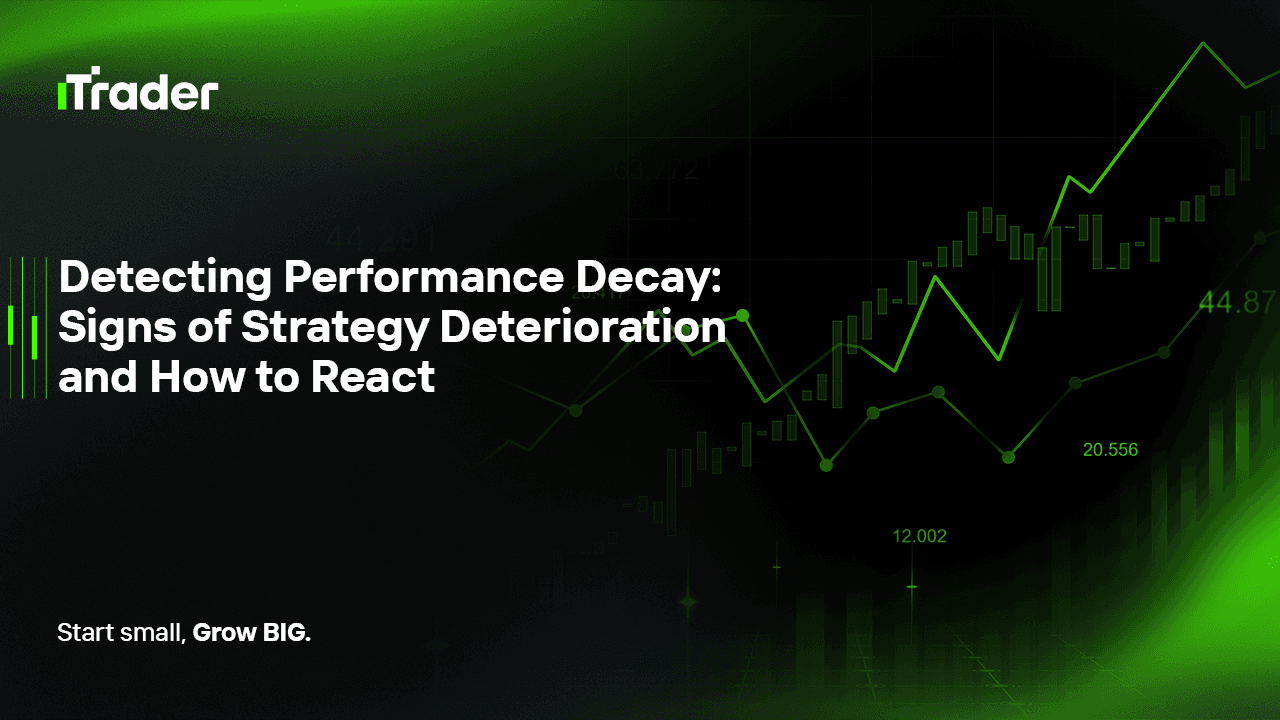2025-06-19
As a beginner in forex trading, finding a strategy that works can feel like discovering treasure. You start to see consistent profits, you feel confident, and everything seems to make sense.
But then—something changes.

The trades that used to work stop working. Wins become smaller. Losses grow. The strategy feels “off.”
This is not just bad luck. This could be a sign of performance decay—when a previously profitable trading strategy starts losing its edge.
In this post, you’ll learn:
Performance decay happens when a trading strategy that once delivered consistent results starts performing worse over time.
This doesn't mean you made a mistake. It means your strategy may no longer match the market conditions.
Just like markets evolve, strategies also have a lifespan. Some work for months, others for years. But no strategy is immune to decay.
The forex market is dynamic. Central bank policy, global sentiment, and volatility constantly shift. A trend-following strategy might stop working in a ranging market, or a breakout strategy might fail when volatility drops.
Some strategies are built specifically for past market conditions (known as backtesting). If your strategy only works on old data and not in real time, it may have been overfit—tailored too perfectly to the past.
Popular strategies can become less effective if too many traders use them. The market adapts, and edges fade as they become predictable.
Even if your strategy is sound, your execution might change. You may take profits earlier, avoid losses out of fear, or break your rules without realizing it. Your own behavior can create decay.
You’re getting stopped out more often, and fewer trades are hitting your targets.
You find yourself in deeper losing streaks than before. Equity curves flatten or start to decline.
Previously, a few winning trades could recover a loss. Now, it takes much longer to bounce back.
You hesitate before trades, second-guess your entries, or feel anxious about using the same rules.
You begin changing stop-loss levels, profit targets, or entry filters without real testing—out of frustration, not logic.
If you suspect your strategy is failing, stop trading live temporarily. Go back to demo trading or small-size trades. Do not let ego push you to “recover” in a decaying system.
Review your past 20–50 trades:
This can help separate strategy failure from execution errors.
Use your trading data to compare:
A consistent drop across multiple metrics often confirms strategy decay.
Run your strategy on recent data—not just old backtests. If your system fails on the last 3–6 months of price action, you’ll know it no longer fits the market environment.
If the strategy can be saved:
If it cannot be saved:
Remember: even top traders retire strategies all the time. It’s part of staying profitable.
Instead of only backtesting your strategy on old data, test it on a rolling window of new data. This simulates real-time adaptation and helps avoid overfitting.
Track your strategy’s performance like a business:
If numbers drop, investigate early.
Log your trades, thoughts, mistakes, and setups. This lets you spot emotional or behavioral patterns that affect your performance.
Never fall in love with a strategy. Love the process. Be ready to evolve as markets do.
Every trader—beginner or advanced—will experience performance decay. It’s not a failure. It’s a sign that it’s time to evolve.
The best forex traders are not those with the "perfect strategy"—they’re the ones who can:
So the next time your once-trusty strategy stops working, don’t panic. Instead, investigate, adapt, and come back sharper.
Your long-term survival as a forex trader depends not on never failing, but on always learning when things stop working.
2025 Ай Трейдер Глобал ХХК | Компанийн бүртгэлийн дугаар: 15962
Ай Трейдер Глобал ХХК нь Комор улсын Анжуан арал дахь Мутсамуду хотын Хамчакод байрлалтай. Тус компани нь Коморын Үнэт Цаасны Хорооноос (Securities Commission of the Comoros) олгосон L15962/ITGL дугаартай тусгай зөвшөөрлийн хүрээнд үйл ажиллагаа явуулдаг.
Ай Трейдер Глобал ХХК нь “iTrader” нэрийн дор үйл ажиллагаа явуулдаг бөгөөд (Форекс) арилжааны үйл ажиллагаа явуулах эрхтэй. Компанийн лого, барааны тэмдэг, вэбсайт нь зөвхөн Ай Трейдер Глобал ХХК компанийн өмч юм.
Ай Трейдер Глобал ХХК -ийн охин компани болох : iTrader Global Pty Ltd, Австралийн компанийн бүртгэлийн дугаар (ACN): 686 857 198. Энэ компани нь Opheleo Holdings Pty Ltd компанийн албан ёсны төлөөлөгч бөгөөд Австралийн санхүүгийн үйлчилгээний төлөөлөгчийн дугаар: 001315037 -тай. Австралийн санхүүгийн үйлчилгээний лицензийн дугаар: 000224485 -тай Level 1, 256 Rundle St, Adelaide, SA 5000 хаягт байршдаг. Анхааруулга: Энэ байгууллага нь энэхүү вэбсайт дээр болон дамжуулан арилжаалагдаж буй санхүүгийн (арилжааны) хэрэгсэл нийлүүлэгч биш бөгөөд ямар нэгэн хариуцлага хүлээхгүй болно.
Эрсдэлийн сэрэмжлүүлэг: CFD арилжааны хөшүүргийн улмаас хөрөнгөө хурдан алдах өндөр эрсдэлтэй тул бүх хэрэглэгчдэд тохиромжгүй байдаг.
Фанд, CFD болон бусад өндөр xөшүүрэгтэй арилжаа нь хэрэглэгчээс нарийн төвөгтэй ойлголтуудын талаар тусгай мэдлэг шаарддаг. Хөшүүрэгтэй арилжаанд оролцогчдын 84.01% нь алдагдал хүлээдгийг судалгаанууд харуулдаг тул хөшүүрэгтэй арилжаанд орохоос өмнө хөрөнгөө алдах маш өндөр эрсдэлтэй болохыг анхаарна уу.
iTrader нь аливаа иргэн, хуулийн этгээдийн өмнө xөшүүрэгтэй арилжааны эрсдэл, алдагдал, бусад хохирлыг бүхэлд нь хариуцахгүй болохыг мэдэгдэж байна.
Энэхүү веб сайтын мэдээ, мэдээлэл нь зөвхөн мэдлэг түгээх зорилготой тул хэрэглэгч та бие даан шийдвэр гаргана уу.
Хязгаарлалт: iTrader нь вэбсайт болон үйлчилгээгээ тухайн орны хууль тогтоомж, дүрэм журмаар хориглосон орнуудад оршин суугчдад чиглүүлдэггүй. Хэрэв та энэхүү вэбсайтыг ашиглахыг хориглосон оронд байгаа бол вэбсайт болон үйлчилгээг ашиглахдаа тухайн орны хууль тогтоомжид нийцэж байгаа эсэхийг шалгах үүрэгтэй. iTrader нь вэбсайтынхаа мэдээлэл бүх оронд тохиромжтой эсэхийг баталгаажуулдаггүй.
Ай Трейдер Глобал ХХК нь зарим улс орны иргэдэд үйлчилгээ үзүүлэхээс татгалздаг болно. Жишээлбэл: АНУ, Орос, Бразил, Канада, Израйл, Иран.